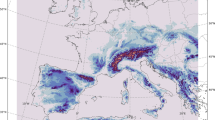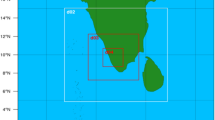Summary
A forced time-dependent 1-D model of Cb cloud is used to investigate the behaviour of injected hailstones. The final hailstone radii and trajectories are calculated for three initial parameters: the initial hailstone radius, the initial hailstone density and the concentration of cloud droplets. The hailstone growth is treated as a unique process with dry, wet and melting regime.
It is shown:
-
1)
For a shallow Cb cloud with a small precipitation zone in the cloud base region the hail growth time is significantly longer than in the case without a forced lifting component. Further the recycling mechanism with/without falling down of the hail occurs.
-
2)
For the high Cb cloud the hail growth time is longer and no recycling occurs in the case with a forced lifting component.
-
3)
The final hailstone radius change is relatively small.
Similar content being viewed by others
References
Browning, K. A., 1977: The structure and mechanisms of hailstorms.Hail: A Review of Hail Science and Hail Suppression. G. B. Foote and C. A. Knight, Eds., Meteor. Monogr., No. 38, Amer. Meteor. Soc., 1–43.
Browning, K. A., Foote, G. B., 1976. Airflow and hail growth in supercell storms and some implications for hail suppression.Quart. J. Roy. Meteor. Soc.,102, 499–533.
Chong, S. L., Chen, C. S., 1974. Water shells on ice pellets and hailstones.J. Atmos. Sci.,3, 1384–1391.
Ćurić, M., 1980: Dynamics of a cold air outflow from the base of the thunderstorm. A simple model.J. Rech. Atmos.,14, 493–498.
Ćurić, M., 1982: The development of the cumulonimbus cloud which move along a valley. In:Cloud Dynamics (eds. E. M. Agee and T. Asai) Dordrecht: D. Reidel Publ. Comp., 259–272.
Ćurić, M., 1985: Inclusion of the local orographic conditions in one dimensional numerical model of Cb clod.Zbornik met. i hid.,12, 156–160.
Ćurić, M., 1986: Areal characteristics of different precipitation type from cumulonimbus in north-western part of Serbia. Preprints from XIX International Conference of Alpine Meteorology in Rauris, Austria (1.–5. 9. 1986), 51–54.
Ćurić, M., Janc, D., 1987: On the influence of entrainment and forced lifting on some products of 1-D model of Cb cloud.Atmospheric Research,21, 151–169.
Dennis, A. S., Musil, D. J., 1973: Calculations of hailstone growth and trajectories in a simple cloud model.J. Atmos. Sci.,30, 278–288.
Drake, J. C., Mason, B. J., 1966: The melting of small ice spheres and cones.Quart. J. Roy. Meteor. Soc.,99, 639–648.
Droegemeier, K. K., Wilhelmson, R. B., 1987: Numerical simulation of thunderstorm outflow dynamics. Part I: Outflow sensitivity experiments and turbulence dynamics.J. Atmos. Sci.,44, 1180–1210.
Dye, Y. E., Jones, J. J., Winn, W. P., Cerni, T. A., Gradiner, B., Lamb, D., Pitter, R. L., Hallett, J., Sounders, C. P. R., 1986: Early electrification and precipitation in a small, isolated Montana cumulonimbus.J. Geophys. Res.,91, 1231–1247.
Farley, R. D., 1987: Numerical modeling of hailstorms and hailstone growth. Part II: The role of low-density riming growth in hail production.J. Climate Appl. Meteor.,26, 234–254.
Foote, G. B., 1984: A study of hail growth utilizing observed storm conditions.J. Climate Appl. Meteor.,23, 84–101.
Grenier, J. C., Admirat, P., Zair, S., 1983: Hailstone growth trajectories in the dynamic evolution of a moderate hailstorm.J. Climate Appl. Meteor.,22, 1008–1021.
Heymsfield, A. J., 1983: Case study of a hailstorm in Colorado. Part IV: Graupel and hail growth mechanisms deduced through particle trajectory calculation.J. Atmos. Sci.,40, 1482–1516.
Langmuir, I., 1948: The production of rain by a chain-reaction in cumulus clouds at temperatures above freezing.J. Meteor.,5, 175–192.
Lin, Y.-L., Farley, R. D., Orville, H. D., 1983: Bulk parameterization of the snow field in a cloud model.J. Climate Appl. Meteor.,22, 1065–1092.
Mason, B. J., 1956: On the melting of hailstones.Quart. J. Roy. Meteor. Soc.,82, 209–216.
Nelson, S. P., 1983: The influence of storm flow structure on hail growth.J. Atmos. Sci.,40, 1965–1983.
Pruppacher, H. R., Klett, J. D., 1978: Microphysic of cloud and precipitation. Dordrecht: D. Reidel Publ. Comp., 714 pp.
Wisner, C., Orville, H. D., Myers, C., 1972: A numerical model of a hailbearing cloud.J. Atmos. Sci.,29, 1160–1181.
Xu, L. J., 1983: Hail growth in a three-dimensional cloud model.J. Atmos. Sci.,40, 185–203.
Ziegler, C. L., 1985: Retrieval of thermal and microphysical variables in observed convective storms. Part I: Model development and preliminary testing.J. Atmos. Sci.,42, 1487–1509.
Author information
Authors and Affiliations
Additional information
With 10 Figures
Rights and permissions
About this article
Cite this article
Curić, M., Janc, D. The behavior of a hailstone in a forced 1-D Cb cloud model. Meteorl. Atmos. Phys. 41, 45–54 (1989). https://doi.org/10.1007/BF01032589
Received:
Revised:
Issue Date:
DOI: https://doi.org/10.1007/BF01032589




